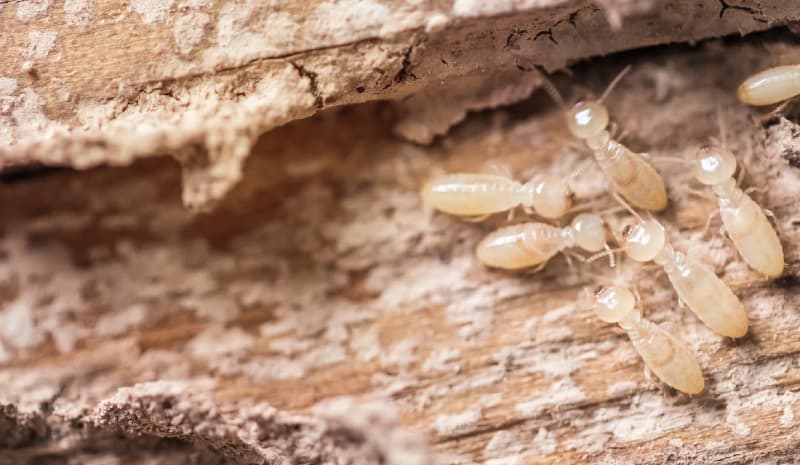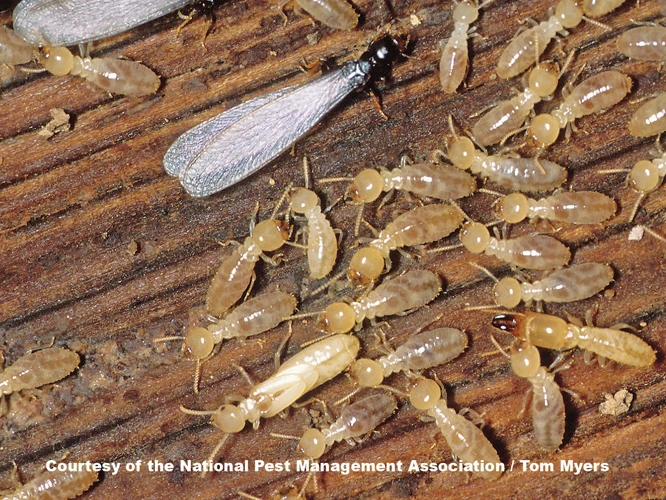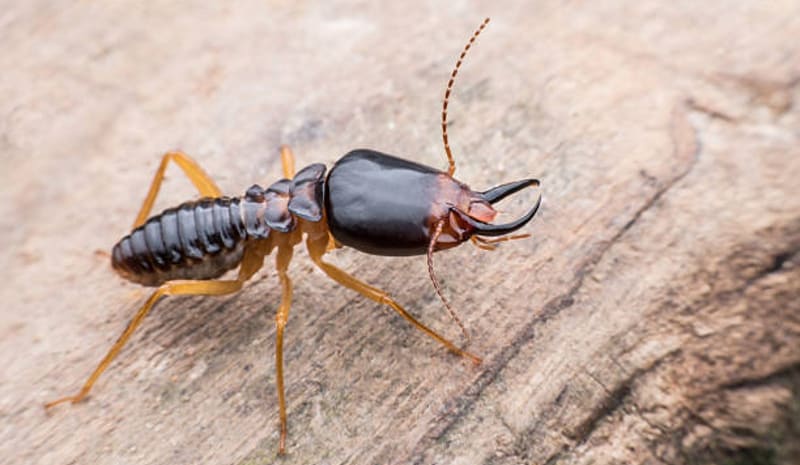Termites are one of the most fascinating insects with a complex social system and intriguing life cycle. From their tiny eggs to their crucial role as workers, soldiers, and reproductives, termites traverse a remarkable journey of development and specialization. This article explores the different stages of the termite life cycle, examining the appearance, diet, behavior, and role of each stage in the colony. So, hold your breath and get ready to delve into the mysterious and captivating realm of termites.
Stage 1: Termite Eggs
 The beginning of a termite’s life is crucial to the entire termite colony. From the moment they are laid, termite eggs play a vital role in the survival and growth of the colony. Understanding the development of termite eggs is key to comprehending the complete termite life cycle. If you want to know more about the complete termite life cycle, including factors affecting termite life cycle and the different stages of termite infestation, check out our detailed article on the complete termite life cycle.
The beginning of a termite’s life is crucial to the entire termite colony. From the moment they are laid, termite eggs play a vital role in the survival and growth of the colony. Understanding the development of termite eggs is key to comprehending the complete termite life cycle. If you want to know more about the complete termite life cycle, including factors affecting termite life cycle and the different stages of termite infestation, check out our detailed article on the complete termite life cycle.
Appearance
Termite eggs are tiny, almost translucent, and white. They are only about 1mm in length and resemble small grains of rice. Since termite eggs are typically laid within the colony, they are rarely seen, making them difficult to identify.
Understanding termite appearance is also crucial for termite inspectors to help determine the appropriate treatment for a termite infestation. For more information, read our article on factors that affect the termite life cycle.
Diet and Behavior
Termite eggs do not have a specific diet as they are yet to hatch and are being taken care of by the queen termite. The primary behavior of termite eggs is to develop and grow into nymphs.
Role in the Colony
The primary duty of termite eggs is to hatch and grow into nymphs.
Stage 2: Termite Nymphs

As the termite eggs begin to hatch, a new stage in the termite life cycle emerges: the termite nymphs. These young termites resemble their adult counterparts, but they are smaller and lack reproductive abilities. Nymphs undergo various molts and gradually develop into the working class of the colony. Let’s delve deeper into the physical characteristics, behaviors, and roles of the termite nymphs in the life cycle.
Appearance
Termite nymphs are slightly bigger than the eggs and are translucent to white in color. They are around 1-4 mm in length and have soft bodies. The termite nymphs look similar to adult termites, but are smaller in size and do not have wings yet.
Diet and Behavior
Nymph termites are fed a liquid diet by worker termites, which assist in molting and growing. In the early stages of their life, they are fed small amounts of food and eventually are given larger portions as they grow. Nymph termites spend their days grooming each other and tending to the eggs.
Role in the Colony
Nymphs work to help the colony expand by building tunnels and taking care of the queen and eggs.
They also molt several times before reaching their final form.
Stage 3: Termite Workers

As we delve further into the life cycle of termites, we come across a fascinating stage – the termite workers. These tiny creatures play a vital role in the functioning of the termite colony, tirelessly working to sustain their communities. Let’s take a closer look at the appearance, behavior, and role of these diligent workers.
Appearance
Termite workers are the most common type of termites found in a colony. They are soft-bodied, wingless termites that are approximately 3mm in length and are creamy white in color. Termite workers have distinct heads and mandibles, which they use to chew wood and create tunnels.
Diet and Behavior
Termite workers are responsible for feeding all other members of the colony. They feed on wood and other material, such as drywall, paper, and fabric. The workers digest this food and break it down into a nutritious substance that is fed to other members of the colony. They also play an important role in maintaining the nest by building and repairing it according to their needs. A mature termite colony may have thousands of worker termites to provide for.
Role in the Colony
As the most numerous caste in the colony, workers have a wide range of responsibilities. They build and maintain the nest, forage for food, and take care of other termites.
Workers are also responsible for feeding and grooming the queen, as well as caring for eggs and young nymphs. In some species, workers can also develop into soldiers if necessary.
Stage 4: Termite Soldiers

As the termite colony grows, certain members develop unique physical characteristics and traits to defend the nest and its inhabitants from predators and threats. These highly specialized members are known as termite soldiers. Unlike worker termites, soldiers are not responsible for foraging or feeding the colony, but rather play a pivotal role in protecting the queen and her reproductive offspring. Let’s dive deeper into the appearance, diet and behavior, and role of termite soldiers in the colony.
Appearance
Termite soldiers are also wingless like workers, but they have a distinct appearance. They have enlarged heads with powerful mandibles that make up a considerable part of their body. The soldiers are usually around 3-6 mm in length, and their bodies are cream or white in color.
Diet and Behavior
Termite soldiers also rely on the workers for their dietary needs, but they have larger mandibles that are used for defense purposes. Soldier termites have a very important job- defending the colony from predators and other threats. They will rush to the site of any disturbance and attack any invader with their powerful mandibles.
Role in the Colony
Soldiers have one main duty: protect the colony from predators.
With their large jaws and tough exoskeletons, soldiers are ready to defend the nest at any time.
Stage 5: Termite Reproductives (Alates)
As the termite colony develops, a special group of termites begins to emerge – the reproductive alates. These termites are the future kings and queens of new colonies, and their emergence is a crucial step in the life cycle of termites. Understanding the appearance, behavior, and role of alates in a termite colony is important for controlling and preventing termite infestations. Let’s take a closer look at the fascinating world of termite reproductives.
Appearance
Termite reproductives are the only termites in the colony with wings. They are typically black or brownish in color and have a length of about 6-10mm, including their wings. They have two pairs of wings, with the front ones larger than the back ones. Once termite reproductives mature, they will fly away from the colony to start a new one.
Diet and Behavior
Termite reproductives have a similar diet to the workers’ and rely on them for food. However, their primary behavior is to swarm to search for a suitable mate and establish a new colony. They fly out of their nests in the thousands and fly up into the air. They will mate with each other, and the mated pairs will each land and start new colonies. These new colonies would have one queen termite and eventually develop their own workers, soldiers, and reproductives.
Role in the Colony
The primary role of alates is to mate and form new colonies.
Once paired up, alates fly off and shed their wings before settling down to become the new king and queen.
They’ll then begin to lay eggs and start the life cycle all over again.
Conclusion
In conclusion, the life cycle of termites from eggs to workers is a fascinating and intricate process. Each stage plays a crucial role in the survival of the colony and the ongoing success of the termite species. From the tiny and vulnerable termite egg to the powerful and mighty alate, each stage of the termite life cycle exhibits unique characteristics and behaviors.
As we have seen, the termite egg hatches into the nymph, which then develops into specialized workers or soldiers. These individuals work tirelessly to construct and maintain the termite colony, while simultaneously defending it against threats. The reproductive alates play a key role in the expansion of the colony, as they search for new areas to establish a termite population.
It is important to remember that termites are not just pests to be eradicated. They are integral parts of many ecosystems, breaking down cellulose and contributing to nutrient cycling. Additionally, the behavior and interactions within termite colonies provide scientists with valuable information about social organization and communication.
Despite their importance, however, termites can cause significant damage to human structures and property. Understanding their life cycle and behavior is crucial for effective and sustainable termite management.
So, whether you find yourself admiring the intricate tunnels and structures of a termite mound or battling an infestation in your home, remember the complex and fascinating life cycle of these tiny but mighty insects.
Frequently Asked Questions
Q: How long does it take for termite eggs to hatch?
A: It typically takes around 2 weeks for termite eggs to hatch into nymphs.
Q: How do termites communicate with each other?
A: Termites communicate with each other through pheromones and vibrations.
Q: Can termite infestations be prevented?
A: Yes, regular inspections and maintenance can prevent termite infestations. Also, keeping wood structures dry and storing firewood away from the house can help.
Q: How long do termite workers live?
A: Termite workers typically live for a few years.
Q: Can termites eat through concrete?
A: Termites can’t eat through concrete, but they can travel through cracks and gaps in the concrete to access wood structures.
Q: Are termites harmful to humans?
A: While termites are not directly harmful to humans, they can cause extensive damage to homes and other wooden structures.
Q: Can a termite infestation be treated without professional help?
A: While there are DIY treatments available, a professional should be consulted to properly and safely treat a termite infestation.
Q: Do termites have predators?
A: Yes, ants, birds, and some mammals like anteaters and armadillos are predators of termites.
Q: Can termites fly?
A: Yes, termite reproductives (alates) have wings and can fly to establish new colonies.
Q: How long do termite reproductives live?
A: Termite reproductives can live for several years and are responsible for establishing new colonies.

